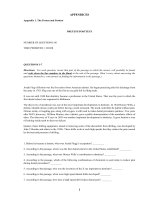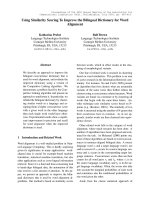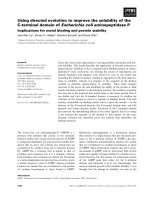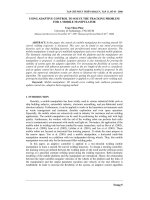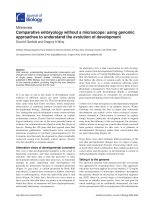Using geospatial technology to map the forest carbon stock in cuc phuong national park
Bạn đang xem bản rút gọn của tài liệu. Xem và tải ngay bản đầy đủ của tài liệu tại đây (853.33 KB, 48 trang )
MINISTRY OF AGRICULTURE AND RURAL DEVELOPMENT
VIETNAM FORESTRY UNIVERSITY
STUDENT THESIS
Title
USING GEOSPATIAL TECHNOLOGY TO MAP
THE FOREST CARBON STOCK IN CUC PHUONG NATIONAL PARK
Major: Natural Resources Management
Code: D850101
Faculty: Forest Resources and Environmental Management
Student: Hoang The Trung
Student ID: 1253090037
Class: K57 Natural Resources Management
Course: 2012 - 2016
Advanced Education Program
Developed in collaboration with Colorado State University, USA
Supervisor: Assoc. Prof. Dr. Phung Van Khoa
Co-supervisor:
Ha Noi, October 2016
i
ACKNOWLEDGEMENT
With the consent of Vietnam National University of Forestry, Faculty of Forest
resources and Environment Management, I carried out the thesis named “Using geospatial
technology to map the forest carbon in Cuc Phuong National Park“.
Firstly, I would like to express my sincere gratitude to my advisor Assoc. Prof.
Phung Van Khoa for the continuous support of my study and related research, for his
patience, motivation, and immense knowledge. His guidance helped me in all the time of
research and writing of this thesis. I could not have imagined having a better advisor and
mentor for my study. I am also thankful to Prof. Lee MacDonald for guiding me to
construct thesis proposal. His comments and criticism on my proposal helped me to present
better final thesis.
Secondly, I deeply appreciate the support MSc. Do Van Lap, MSc. Nguyen Ngoc
Cuong, Mr. Nguyen Quang Hau and the staffs working in Cuc Phuong National Park for
the enthusiastic help during my works.
Thirdly, I would like to express my gratitude to one and all who, directly or
indirectly, have lent their helping hand in this venture.
Finally, I would also like to thank a lot my family for their understanding, patience
during my study and supporting me spiritually throughout my life.
Due to the limited knowledge and experiences, this report is not finalized yet. I am
looking forward to receiving feedback from teachers and friends to improve this thesis.
Hanoi, October, 2016
Hoang The Trung
ii
LIST OF TABLE
ACKNOWLEDGEMENT .....................................................................................................ii
LIST OF TABLE ..................................................................................................................iii
LIST OF ABRREATION ...................................................................................................... v
LIST OF TABLE .................................................................................................................. vi
LIST OF FIGURE ...............................................................................................................vii
ABSTRACT........................................................................................................................viii
I. INTRODUCTION .............................................................................................................. 1
II. GOALS AND SPECIFIC OBJECTIVES ......................................................................... 4
2.1. Goals ............................................................................................................................... 4
2.2. Scope of object................................................................................................................ 4
2.3. Specific objectives .......................................................................................................... 4
III. STUDY AREA AND METHODOLOGY ...................................................................... 5
3.1. Study area ....................................................................................................................... 5
3.2. Data sources .................................................................................................................... 7
3.3. Methodology ................................................................................................................... 7
3.3.1.Create image classification ........................................................................................... 8
3.3.2. Mapping forest status ................................................................................................. 11
3.3.3. Mapping forest volume .............................................................................................. 11
3.3.4 Mapping Carbon Stock. .............................................................................................. 12
IV. RESULTS ...................................................................................................................... 14
4.1. Land cover classification map of Cuc Phuong National Park ...................................... 14
4.2. The forest volume map in Cuc Phuong National Park of Cuc Phuong commune........ 22
4.3. The map of forest carbon in Cuc Phuong National Park of Cuc Phuong commune .... 24
4.4. Mapping the Carbon Dioxide absorbed ........................................................................ 25
iii
4.3. Proposing solutions to improve the management of forests in Cuc Phuong commune 28
V. DISCUSSION ................................................................................................................. 30
VI. CONCLUSION ............................................................................................................. 31
REFERENCES
APPENDIX
iv
LIST OF ABRREATION
GIS: Geographic Information System
RS: Remote sensing
NDVI: Normalized Difference Vegetation Index
IPCC: ntergovernmental Panel on Climate Change
AGB: Above ground biomass
CDM: Clean Development Mechanism
CER: Certified Emission Reduction
COP: Conference of the Parties
REDD: Reducing Emissions from Deforestation and Degradation
FAO: Food and Agriculture Organization
MARD: Ministry of Agriculture and Rural Development
UNFCCC: United Nations Framework Convention on Climate Change
v
LIST OF TABLES
Table 3.2.1: Technical parameters and properties of the sensors used in this study ............. 7
Table 3.3.1: Data collection ................................................................................................. 10
Table 3.3.2: Forest Status .................................................................................................... 11
Table 4.1.1: NDVI value for water ...................................................................................... 14
Table 4.1.2: NDVI value for others ..................................................................................... 15
Table 4.1.3: NDVI value for Bamboo forest based-object .................................................. 16
Table 4.1.4: NDVI value for poor forest ............................................................................. 16
Table 4.1.5: NDVI value for restored forest ........................................................................ 17
Table 4.1.6: NDVI value for plantation based-object .......................................................... 17
Table 4.1.7: NDVI value for medium forest ........................................................................ 18
Table 4.1.8: NDVI value for rich forest............................................................................... 18
Table 4.1.9: NDVI range for each land cover class in Cuc Phuong National Park ............. 19
Table 4.1.10: Summarized accuracy of objects ................................................................... 21
Table 4.1.11: The status forest map in Cuc Phuong commune ........................................... 22
Table 4.2.1: Forest volume of Cuc Phuong National Park .................................................. 23
Table 4.3.1: Total forest carbon in Cuc Phuong National Park ........................................... 25
Table 4.4.1: The CO2 absorbed in Cuc Phuong National Park at Cuc Phuong Commune .. 26
vi
LIST OF FIGURES
Figure 3.1.1: Map of study area: (a) Land border map of Vietnam. (b) Ninh Binh Province.
(c) Cuc Phuong commune, Nho Quan Districts .................................................................... 5
Figure 3.3.1: The processing steps of study........................................................................... 7
Figure 3.3.2: Plot sampling design ........................................................................................ 9
Figure 3.3.3: The layout of distribution points .................................................................... 10
Figure 4.1.1: The status forest map in Cuc Phuong commune ............................................ 20
Figure 4.2.1: The forest volume map in Cuc Phuong commune ......................................... 23
Figure 4.3.1: The forest carbon map in Cuc Phuong National Park of Cuc Phuong
commune .............................................................................................................................. 24
Figure 4.4.1: The CO2 absorbed map in Cuc Phuong commune ......................................... 26
Figure 4.4.2: Figure carbon absorb value of different forest types in CPNP ...................... 27
vii
ABSTRACT
Using Remote Sensing and GIS techniques to build the map of forest resources,
determine the biomass and carbon stock of forest, are a new direction in the application of
geospatial technology and cost effective method to inventory in forestry. The overall
objectives of this study are to map out forest cover using SPOT-5 image and establish a
map of forest carbon in Cuc Phuong commune, Ninh Binh province. The overall objectives
of this study are to map out forest cover using SPOT-5 image and establish a map of forest
carbon in Cuc Phuong commune, Ninh Binh province. ECognition Developer, ArcGIS and
MapInfo softwares were used for classification and mapping. Based on the results of
classification indices from ground survey, segmented imagery of SPOT-5 and NDVI index
were classified into 8 land cover classes: (1) rich forest, (2) medium forest, (3) poor forest,
(4) restored forest, (5) bamboo forest, (6) plantation forest, (7) water body, (8) Others.
With total area of study site is 13,109.84 ha.
Results showed that the total forest carbon in Cuc Phuong National Park is
1,480,000 tons. This rich forest is the largest 9447.62ha, (represent 70.07% total), with the
volume of forest is 298.1 (m3/ha) and 257,493.81 ton carbon (represent 85.52% in total).
Restored forest is the lowest, with 203.74 (m3/ha), 8,126.96 ton carbon (represent 0.55 %
in total).The carbon stock and CO2 absorbed for rich forest in forest at Cuc Phuong
commune with the highest value around 133.1 ton/ha and 488.04 ton/ha, respectively.
viii
I. INTRODUCTION
Forests cover approximately 30% of the world’s total land mass (FAO, 2010) and are
an integral part of life on earth, providing services at local, national and global levels. But the
impacts of climate change are far-reaching, and will also affect forests, and the livelihoods of
people who depend on them. Scientists have predicted that by 2100, global temperatures will
rise from 1.8 to 4 ° C again and sea level will likely rise at about 0.75 - 1.5 m due to the
greenhouse effect. Greenhouse effects are caused by several factors which include dust,
steam, industrial emissions (which mainly some substances are listed in the order: CO2, CFC,
CH4 ...) of the plant and equipment, vehicles that use fossil fuels, carbon stem, volcanic
activity, the nuclear explosion ... caused environmental pollution. Deforestation and forest
degradation is also an important factor - this is a source of greenhouse gas emissions
significantly contribute to climate change (according to the report submitted at the meeting to
discuss US climate group held in Bonn, Germany on 30/03/2009, the "deforestation is
responsible for nearly one fifth operation overall greenhouse gas emissions"), this situation
dose not only occurs in developing countries in the tropics, but in recent years the "forest fire
incident" has occurred frequently and more severe even in developed countries like USA and
Russia - which destroyed thousands of hectares of forest / crop.
Studying the role of forests in protecting the environment, as well as its ability to
provide direct use, such as timber, wood, non-timber forest products...etc., have implemented
in many countries around the world including in Vietnam. The value of carbon absorption
capacity of forests plays a very important role in the elimination of greenhouse gases, thus
contributes to reducing global climate change. Value for carbon sequestration by forests could
be commercialized under various mechanisms such as payment for environmental services
(PES) and Reducing Emissions from Deforestation and Forest Degradation in tropical
countries (REDD & REDD + ). The Clean Development Mechanism (CDM - clean
1
development mechanism) provided for in Article 12 of the Kyoto Protocol (KP) of the
Convention of the United Nations Framework on Climate Change (UNFCCC) for developing
countries states that the CO2 that the plantations to absorbed CO2 is regarded as a measure to
reduce greenhouse gas emissions, however, the value of qualitative research and the benefits
in terms of new environment is just the first step in the world and is a completely new issue in
Vietnam.
In recent years, the advancement of Geographical Information Systems (GIS) and
Remote Sensing (RS) technologies provide valuable information on natural resources
management. Recent improvements in satellite imagery availability allowed researchers to
perform image analysis at much larger scale than in the past. Currently, Remote Sensing is
widely used to collect information regarding forest above-ground biomass (AGB) and
vegetation structure as well as to monitor and map vegetation biomass and productivity on
large scales which is done by measuring the spectral reflectance of the vegetation. However,
optical RS does not directly assess above-ground forest biomass, and radiometry is sensitive
to vegetation structure (i.e., crown size and tree density), texture, and shadow, which are
correlated with AGB, particularly in the infrared bands (Lu, D et al., 2013). RS data are now
considered to be the most reliable method of estimating spatial biomass in tropical regions
over large areas. RS technology has been applied to biomass assessment in many studies
(Kankare et al., 2013) because it can obtain forest information over large
areas at a
reasonable cost and with acceptable accuracy based on repetitive data collection
with
minimal effort (Lu, D et al., 2006).
Forest have long been regarded as a nation treasure in Cuc Phuong national park. In
addition, those forests provide resources such as grazing land for animals, wildlife habitat,
water resources, timber and non-timber products for local people. However, human activities
are posing a serious threat to quality and quantity of forest. Studies to quantify carbon
2
biomass for mountain forest ecosystems is needed to determine the value of forests through
carbon accumulation capacity, in the mountain where is not just of academic exchanges but
also a place to provide the best eco-services for tourism development. From this idea, I would
like to choose this study named "Using geospatial technology to map the forests carbon in
Cuc Phuong National Park" for the student graduation thesis.
3
II. GOALS AND SPECIFIC OBJECTIVES
2.1. Goals
Assessing the carbon stock of the forests and contribute basic scientific information
which propose the solutions for sustainable forest management and development in Cuc
Phuong National Park, Cuc Phuong commune, Ninh Binh province.
2.2. Scope of object
Studying the forests of Cuc Phuong national park in Cuc Phuong commune, Nho Quan
district, Ninh Binh province.
2.3. Specific objectives
-
Mapping the land cover in study site from SPOT 5 imagery
-
Estimating and mapping the forest volume in study area from SPOT 5 imagery
-
Estimating and mapping the aboveground carbon stock of forests in study area
-
Proposing possible solutions to enhance forest management in study area
Hypothesis:
The forests carbon stock in Cuc Phuong Natinal Park at Cuc Phuong commune over
1,000,000 ton.
4
III. STUDY AREA AND METHODOLOGY
3.1. Study area
The study site includes the forests of Cuc Phuong national park in Cuc Phuong
Commune, Nho Quan District, Ninh Binh Provinces (Figure 3.1).
Figure 3.1.1: Map of study area: (a) Land border map of Vietnam. (b) Ninh Binh
Province. (c) Cuc Phuong commune, Nho Quan Districts
5
Cuc Phuong National Park has geographical coordinates from 20014’ to 20024’ North
latitude, from 105029’ to 105044’ East longitude, between the provinces of: Ninh Binh, Hoa
Binh and Thanh Hoa. The total area of this National Park in Ninh Binh is 11,330 ha (51.1%),
in Hoa Binh is 5.850 ha (26.4%), and in Thanh Hoa is 5000 ha (22.5%). Cuc Phuong National
Park in particularly, is at 350m above sea level, the annual average temperature is 20,6 oC and
the highest and lowest average temperature are 19,9 oC and 21.2 oC, respectively. The annual
average precipitation of Cuc Phuong National Park fluctuates from 1800 mm to 2400 mm.
The annual average relative air humidity of Cuc Phuong National Park is 90%, the lowest
relative air humidity is higher than 88%. The absolute humidity varies like temperature in air,
which is positive aspect for flora and fauna in national Park. The flora in the park is
remarkably luxuriant with the highest emergent layer attains 40-50m and is characterized by
the dipterocarp Parashorea stellate (as high as 70m). The second and main layer comprises
both semi-evergreen and also a few deciduous species, depending on the degree of shelter
enjoyed. Deciduous Terminalia myriocarpa and Pometia pinnata reach 25-30m. A dense
canopy is formed by the sclerophyllous evergreen member of the families Fagaceae, mostly
Castanopsis
and
Lithocarpus,
Lauraceae
such
as
Cinnamomum,
Lindera
and
Caryodaphnophis. The third layer at about 15m is made up mostly of Caesalpinaceae trees.
The fourth layer consists of smaller bushes and shrubs mixed with saplings of the taller
canopies dominated by Sterculiaceae and wild bananas (Musaceae). The fifth layer or
undergrowth is made up of herbs, comprising members of Rubiaceae, Araceae,
Commeliaceae, Urticaceae and numerous ferns, reaching 2m in height. The park also contains
numerous species which have practical uses such as spices, edible fruits, nuts, shoots, spices
and medicines (MacKinnon, n.d.). The only gymnosperm found at higher altitudes is
Podocarpus wallichianus (F. Ramade, pers. comm., 1984). More than 2,000 vascular plants
grow in the park (J. MacKinnon, pers. comm., 1987) and several endangered and endemic
species are found (Trung, 1985). The park may support as many as 300 species of birds, 65
species of mammals, 37 species of reptiles and 16 species of amphibians.
6
3.2. Data sources
Studying the use inheritance to collect data with the following information:
- SPOT 5 satellite image collected 2015 in study area were provided by Institute for
Forest Ecology and Environment of Vietnam National University of Forestry (IFEE). Table 1
presents configuration details of the SPOT5 imagery.
Table 3.2.1: Technical parameters and properties of the sensors used in this study
SPOT-5 (HRG)
480–710 (pan)
500–590 (green)
610–680 (red)
790–890 (NIR)
1580–1750 (mid IR)
1.5 × 1.5 (m/pxl)
1.5 (m)
Band Wavelength (nm)
Spatial Resolution (m) Pixel Size
3.3. Methodology
The proposed methodology is illustrated in Figure 3.2. Software eCognition Developer
v8.9, MapInfo Professional 12.5 and ArcGIS desktop 10.2 were used.
Figure 3.3.1: The processing steps of study
7
3.3.1. Create image classification
The study used eCognition v8.9 image analysis software for pre-analysis image SOPT 5
and NDVI for key of image classification
eCognition v8.9 image analysis software
Using the eCognition v8.9 image analysis software (Baatz et al., 2004) for image
segmentation. The first step in object-based image analysis is segmentation. In general, image
segmentation is defined as the process of partitioning an image into separated regions based
on parameters specified (Myint et al., 2008) [12]. These parameters often consider the
homogeneity/heterogeneity of regions (Pal et al., 1993) [14].
With Function: Multiresolution segmentation of eCognition software used to classify
homogenous areas in images located within the boundaries of the three types of forest
planning of the basin into lots of small size status, also known as sub-plot. (Index: Scale parameter=20,
shape=0.1, Compactness=0.5. Exports to the file including boundary maps of forest plots with status
information on the average value, the standard deviation of each channel.
Normalized Different Vegetation Index (NDVI)
The study used NDVI to map the status of forest in Cuc Phuong National Park with 60
sample plots and 65 points in study area. NDVI is calculated by following formula:
NDVI
Nir Re d
Nir Re d
Where: Nir spectral reflectance values of the near-infrared channel (Band 3), the
spectral values of channel Red (Band 2) in Spot 5.
According to the typical sample survey method, based on the list of the state's forest
basin Circular No. 34/2009 / TT-BNN, results delineated plots of state and the distribution of
forest status subjects were surveyed in the region 60 plots and 65 points were created to
8
determine the status, forest reserves and test accuracy interpretation of maps (20 plots and 22
points for test accuracy). Plots and secondary survey are distributed across all forest states,
depending on how much the distribution and extent of access to forest conditions that the
number of plots and the secondary survey of each forest state are different .
For each sample plot in the study area is highly variable in terms of topography
and vegetation types in Cuc Phuong national park. The size and shape of the sample plots
is a trade-off between accuracy, precision, time, and cost of measurement. The most
appropriate size and shape may also be dependent on the vegetation type found in the
sampling area. The plot size is a 25m x 40m square, locate with GPS have high accuracy,
measure the diameter at breast height (DBH) tree height, by specialized measures
according to regulations on investigation of foreign industrial data collection. After set up
a sample plot of 1000m2, I continue to make 5 sub-plots of 4mx4m like Figure 3.2 and
start to get an information of the plot such as shrub in sub-plots.
Figure 3.3.2: Plot sampling design
9
Figure 3.3.3: The layout of distribution points
Table 3.3.1: Data collection
No.
Name
X
Y
D13(Average)
H(Average)
Note
Overlay the investigated position of plots and points to boundary map. Tagging land cover
classes with their NDVI values and statistical analysis of NDVI values for each land cover
classes to construct the key of image classification.
10
3.3.2. Mapping forest status
When the thesis had the key of image classification for each based-object in study area,
use keywords defined names forest conditions, identify key forest reserves to image
interpretation and mapping of forest status in study area by grouping the NDVI value for each
based-object with reclassification in analysis tool.
Assessing accuracy of classification
Accuracy assessing is an important part of the image classification procedure and can be
computed by assessing either positional of thematic accuracies. The thesis used matrix table
that is the most commonly to assess the agreement of classification in remote sensing, check
the precision of classification in mapping with 22 points (with 2 points for Water, 5 points for
Plantation, 5 point for Bamboo and 10 points for Others) and 25 plots (5 plots for each forest
type).
3.3.3. Mapping forest volume
Overlay the forest allocation map to forest status map and calculator forest volume for
each forest types and create forest volume map. The study calculated forest volume based on
the 60 sample plots created before.
Table 3.3.2: Forest Status
No
Status
Volume (m3/ha)
1
Rich
>200
2
Medium
100-200
3
Poor
50-100
4
Restored
10-50
5
Other (Bare land, grass)
<10
(Source: The circular 34, Ministry of Agriculture and Rural Development)
11
3.3.4 Mapping Carbon Stock.
The following formula were used to calculate carbon was assessed in five forest carbon
pools, which is in accordance with the IPCC 2006 GL (Estrada 2011). These forest carbon
pools are:
1. Aboveground vegetation: carbon stocked in live and standing vegetation (trees,
shrubs, undergrowth and regeneration)
2. Belowground vegetation: carbon stored in roots
3. Dead wood: carbon stored in standing and fallen dead trees and shrubs
4. Litter: carbon in shed leaves and fine branches
5. Soil: carbon stored as soil organic matter
Base on scope of object, I only interested in carbon stock in aboveground biomass
including: Aboveground vegetation. Using data form the volume forests with the Biomass
Conversion and Expansion Factors (BCEF), the formula:
=∑
∑
(IPCC 2006)
Where:
Aboveground biomass carbon stock of trees in plot sp, in stratum i at time t=0; t
C
Merchantable volume of tree l of species j in plot sp in stratum i at time t=0, m3
Biomass conversion and expansion factor for conversion of merchantable
volume to total aboveground tree biomass for tree species j; dimensionless
Carbon fraction of biomass for tree species j;
L
1, 2, 3, … Nj,sp,i,t sequence number of individual trees of species j in sample
plot sp in stratum i at time t
I
1, 2, 3, …M strata
j
t=0
With
1, 2, 3 … S tree species
0 years elapsed since start of the project activity
=0.47 (Andreae and Merlet, 2001; Chambers et al., 2001; McGroddy et al.,
2004; Lasco and Pulhin, 2003)
12
BCEF for nature forests in North Central Vietnam here:
Growing stock level (m3)
<10
11-20
21-40
41-60
61-80
80-120
120-200
>200
9.0
4.0
2.8
2.05
1.7
1.5
1.3
0.95
BCEFs
(Sources: 2006 IPCC Guidelines for National Greenhouse Gas Inventories)
Evaluate carbon value for forest environmental services
Amount of CO2 absorbed = Carbon *44/12
- According to the Forest Science Institute of Vietnam
Carbon Price = Amount of CO2 * Price (USD/tonCO2)
-
The price in the carbon dioxide:
• Low price: 5 USD / ton CO2
• High price: 11 USD / ton CO2
• $ 1 = 22300 VND exchange rate at the time of the study.
13
IV. RESULTS
4.1. Land cover classification map of Cuc Phuong National Park
The study used NDVI to map land cover in study site, which has the different NDVI
range for eight land cover classes, namely water, bare land, plantation, grasses, restored
forest, medium forest and rich forest. GPS is used for marking 10 plots that are each object
surface cover, Restored forest, Poor forest, Medium forest, and Rich forest, except water have
8 points, Others (including bare land, grasses and residential) have 15 points, Plantation have
10 points and Bamboo forest have 10 points.
Table 4.1.1: NDVI value for water
No.
Location
X
Y
NDIV
1
Cuc Phuong
566462
2249356
-0.32512 Water
2
Cuc Phuong
566397
2249011
-0.39336 Water
3
Cuc Phuong
563314
2248181
-0.29325 Water
4
Cuc Phuong
566699
2245988
-0.21324 Water
5
Cuc Phuong
566535
2246368
-0.19387 Water
6
Cuc Phuong
564879
2247033
-0.14374 Water
7
Cuc Phuong
572336
2246403
-0.10354 Water
8
Cuc Phuong
567317
2244721
-0.09021 Water
Max
-0.09021
Min
-0.39336
14
Note
Table 4.1.2: NDVI value for others
No.
Location
X
Y
NDIV
1
Cuc Phuong
573092
2245544
-0.09121 Bare land
2
Cuc Phuong
567468
2245113
-0.08012 Bare land
3
Cuc Phuong
567662
2245429
-0.07082 Residential
4
Cuc Phuong
565455
2247618
-0.06095 Bare land
5
Cuc Phuong
565933
2247395
-0.05268 Road
6
Cuc Phuong
566475
2247108
-0.05529 Bare land
7
Cuc Phuong
566740
2246972
-0.04674 Bare land
8
Cuc Phuong
567302
2246926
9
Cuc Phuong
566253
2247368
-0.02324 Grass
10
Cuc Phuong
565709
2247554
-0.01387 Bare land
11
Cuc Phuong
565453
2247932
-0.01573 Bare land
12
Cuc Phuong
567572
2246858
-0.00374 Bare land
13
Cuc Phuong
567894
2246471
-0.01225 Grass
14
Cuc Phuong
568296
2246001
-0.00354 Bare land
15
Cuc Phuong
568650
2245634
-0.03325 Grass
0.24263 Residential
Max
0.24263
Min
-0.09121
15
Note
Table 4.1.3: NDVI value for Bamboo forest based-object
No.
Location
X
Y
NDIV
1
Cuc Phuong
566729
2247935
0.53498 Bamboo forest
2
Cuc Phuong
566151
2246622
0.55937 Bamboo forest
3
Cuc Phuong
565897
2246114
0.62529 Bamboo forest
4
Cuc Phuong
564215
2245007
0.58432 Bamboo forest
5
Cuc Phuong
567234
2246104
0.57061 Bamboo forest
6
Cuc Phuong
567055
2245582
0.60253 Bamboo forest
7
Cuc Phuong
566738
2245250
0.64716 Bamboo forest
8
Cuc Phuong
566426
2245173
0.63023 Bamboo forest
9
Cuc Phuong
566006
2248726
0.59139 Bamboo forest
10
Cuc Phuong
564862
2248976
0.54986 Bamboo forest
Max
0.64716
Min
0.53498
Note
Table 4.1.4: NDVI value for poor forest
Volume
No.
Location
X
Y
(m3/ha)
1
Cuc Phuong
563052
2250314
97
0.71532 Poor forest
2
Cuc Phuong
561632
2251055
65
0.71529 Poor forest
3
Cuc Phuong
561114
2251432
83
0.75492 Poor forest
4
Cuc Phuong
561114
2251432
80
0.73312 Poor forest
5
Cuc Phuong
560409
2252173
72
0.74521 Poor forest
6
Cuc Phuong
559977
2252016
63
0.75273 Poor forest
7
Cuc Phuong
561988
2251898
81
0.72302 Poor forest
8
Cuc Phuong
564189
2249431
75
0.73065 Poor forest
9
Cuc Phuong
563139
2250693
93
0.74292 Poor forest
10
Cuc Phuong
563183
2251574
84
0.73582 Poor forest
16
NDIV
Max
0.75492
Min
0.71532
Note
Table 4.1.5: NDVI value for restored forest
Volume
No.
Location
X
Y
(m3/ha)
1
Cuc Phuong
564999
2249563
41
0.64783 Restored forest
2
Cuc Phuong
564099
2247292
45
0.66529 Restored forest
3
Cuc Phuong
564537
2247412
40
0.70586 Restored forest
4
Cuc Phuong
564668
2247750
47
0.68312 Restored forest
5
Cuc Phuong
567210
2247547
48
0.68452 Restored forest
6
Cuc Phuong
565277
2248596
39
0.70273 Restored forest
7
Cuc Phuong
565611
2249057
40
0.71526 Restored forest
8
Cuc Phuong
565168
2248076
43
0.70302 Restored forest
9
Cuc Phuong
564190
2248883
38
0.69392 Restored forest
10
Cuc Phuong
563338
2249841
33
0.71496 Restored forest
NDIV
Note
Max
0.71526
Min
0.64783
Table 4.1.6: NDVI value for plantation based-object
Volume
No.
Location
X
Y
(m3/ha)
NDIV
1
Cuc Phuong
567987
2246125
80
0.29856 Plantation
2
Cuc Phuong
570409
2242782
80
0.24874 Plantation
3
Cuc Phuong
566966
2247203
70
0.48579 Plantation
4
Cuc Phuong
562629
2251062
70
0.25963 Plantation
5
Cuc Phuong
562686
2251663
100
0.53468 Plantation
6
Cuc Phuong
561972
2252441
65
0.53061 Plantation
7
Cuc Phuong
562253
2252349
65
0.46253 Plantation
8
Cuc Phuong
562806
2251363
80
0.24874 Plantation
9
Cuc Phuong
563612
2248320
100
0.50492 Plantation
10
Cuc Phuong
565839
2247783
70
0.24363 Plantation
Max
0.53468
Min
0.24363
Note
(Sources: Cuc Phuong National Park - Studying using data and documents about forest
volume of plantation at Cuc Phuong National Park managers in 2016)
17

